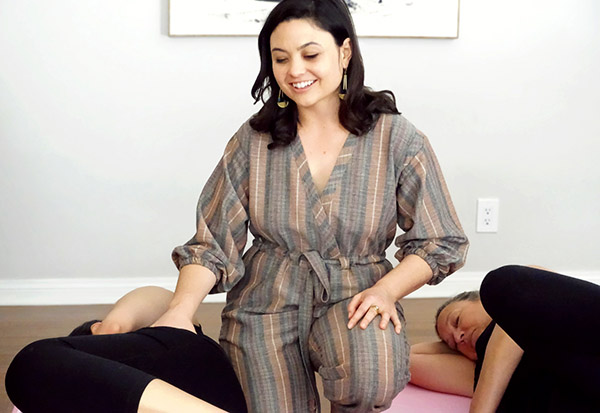Embodiment as a Feminist Practice
BY MADISON PAGE
“The body uses its skin and deeper fascia and flesh to record all that goes on around it. Like the Rosetta Stone, for those who know how to read it, the body is a living record of life given, life taken, life hoped for, life healed.”
–Clarissa Pinkola-Estés, Women Who Run with the Wolves
The human body is an organism that relates to and is shaped by its environment. For many of us, this fact feels antithetical to our existence. As a dancer, movement facilitator and Pilates instructor, I know that the sum of our ontology lives in our bodies and is made manifest through sensation, how we respond anatomically or emotionally to stressors, and through tensegrity, how our muscles, tendons, ligaments and fascia are in agreement or disagreement with our bones and one another. Thus, daily interactions and actions, relationship to self, others, culture and environment make for structural changes and adaptations in the human organism. Budding embodied research from communities of dance like Axis Syllabus and pioneers of natural movement like Katy Bowman echo similar truths how western culture might improve its relationship to the body by means of biomechanically sound exercise and movement. These perspectives establish a collaboration with the human structure as opposed to imposing our cultural and societal will on it.
Here are some facts about the body and its relationship to environment:
- The spine’s natural curves exist because of gravity’s effects on the biggest masses in the body-the head and the pelvis.
- Lordosis (the natural curve of the low spine) is caused by the environmental gravitational pressures imposed when a baby stops crawling and learns how to walk.
- The basis for nature’s energetic and architectural principles also correspond to movement patterns in the human body.
Our bodies carry a conscientiousness of who we are: everything we’ve decided to be but, more pertinent to this writing, everything our community has imposed on us and we’ve embodied unconsciously. As a woman in this culture, for example, I may (through no fault of my own) unknowingly exaggerate the natural curves of my spine as a point of gaining cultural capital, attention and sexual advances. Female representation in pop culture shows this posture to be sexy and attractive. From a purely anatomical perspective, what might happen to the spine, viscera and muscle function from prolonged periods of maintaining this posture? Some repercussions I’ve seen, just to name a few:
- abdominals that cannot stabilize such hyperactivity in motion
- compressed/ overworked low back (propensity for disc bulging, herniations)
- compromised respiratory function (anxious breath pattern: breath cannot travel beyond chest)
- inflexible spine
- tight hip flexors
- weak glutes
- compensatory joint instability that will travel above and below the spine
On another spectrum, I too often see women in my classes who have described themselves as giving up on their bodies after a decades long hiatus from exercise. One such client, having severe kyphosis (hunchback) and low bone mass, first came into the studio with her eyes cast downward, claiming “she’s never been much of a strong person.” During her sessions, she moves hesitantly, sometimes fearfully, as if she’s bracing herself for what’s to come. Her head permanently cocks to one side as her eyes dart around. She apologizes verbally if I offer an encouraging correction, but her whole body has been apologizing long before she mutters, “I’m sorry.” The body acts as a truth-telling device in these instances.
Facebook COO Sheryl Sandberg made the phenomenon of women apologizing a topic of current conversation, but this issue remains moot without discussion on the implications of how a personality such as this might be perceived. Profuse apologies wouldn’t be that big of a deal if one’s success in American culture wasn’t predicated on an ability to adopt historically masculinist characteristics—drive, self-will, confidence and fast execution. In short, internalized and externalized sexism puts the female body at greater risk for developing health issues, and I argue is a determinant factor in one’s ability to manifest success and self-satisfaction in daily life.
I propose that feminism begins literally within each body. I suggest that aligning our bodies from our deepest core muscles has massive spiritual, emotional and sociological implications. With such an activation, I have seen women embody personal power, gut strength and intuition. I am proposing that we investigate our physical fitness regimens and instead build them from sound anatomical principles and the cyclical nature of the body’s systems.
What if:
We dismantled myths about female body image by investigating the miraculous ways in which our bodies are in a constant process of building up and breaking down?
We moved our upper and lower halves of our bodies more towards the middle?
We replaced physical fitness with a class on finding all the spirals in the body?
Fitness was analogous to nap time?
Artists enjoyed the cyclical nature of an artistic process instead of imposing a product based one?
We discussed over coffee a new discovery that we could feel the weight of our brain for the first time, instead of how much exercise we are getting?
In doing so, we introduce ourselves to ourselves, more deeply, without apology, and free from exclusionary ideals. We can then come into bodies that have been waiting to be fully activated, fully experienced, for far too long.
~~
Madison Page is the CEO of Core to Coeur – an inclusive wellness community to meet and move in virtual classes.

